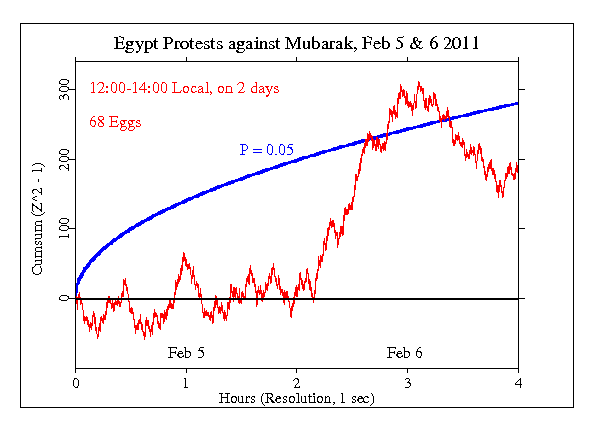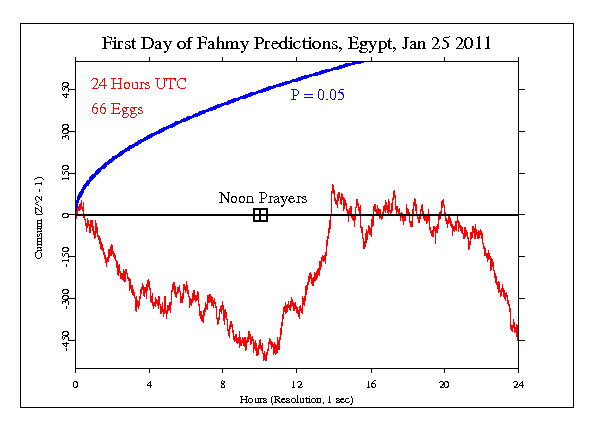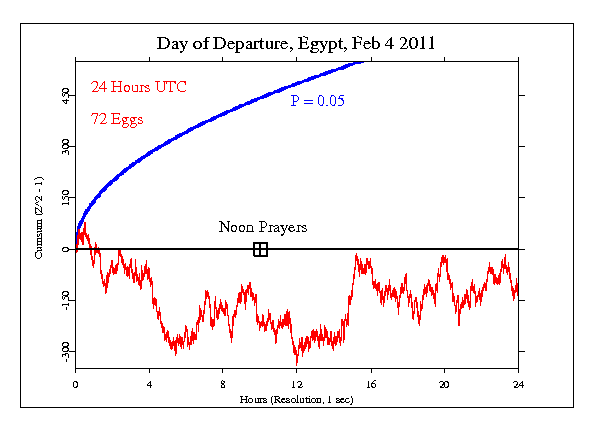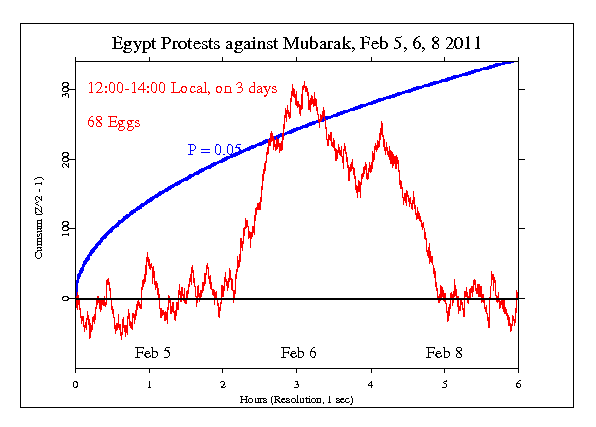Egypt Mubarak Protests, Feb 5 & 6 (& explorations) |
|
Our Egg in Cairo was down for a time, and when its host, Dr Ahmed Fahmy, sent a note to say they were able to bring it back online, he also asked how the Egg network "would interpret the last 12 days". I responded that I wish we had a way of looking at long periods of time, but our "instrument" is best for looking at sharply focused events, a few hours or maybe as much as a day. Dr Fahmy suggested the 5th Feb and also 6th Feb, saying "Mind you [the] equipment is within 5 km of Tahrir square..." I asked whether there is a period of time within the day on the 5th and 6th, or whether it would make sense to consider the whole 24 hours to be representative? Given this question, he further refined his suggestion to a period after the noon prayers, "On the 5th at around 12.45 -1:30 cairo time after the main Friday Muslim Prayer, and on the 6th around same time muslim and christian prayers for the those killed in the crisis same time roughly." The GCP event was set for the 2-hour block on these two days, intended to be concatenated into a single 4-hour block of time. The UTC times for both days are 10:00 to 12:00. The result is Chisquare 14584 on 14400 df, for p = 0.139 and Z = 1.084. The graph shows no trend for the 2 hours on the 5th but much greater activity on the 6th. Following the formal event analysis, which specified Feb 5 & 6, I did some explorations, guided by Dr Fahmy's observations. They are described below.

It is important to keep in mind that we have only a tiny statistical effect, so that it is always hard to distinguish signal from noise. This means that every "success" might be largely driven by chance, and every "null" might include a real signal overwhelmed by noise. In the long run, a real effect can be identified only by patiently accumulating replications of similar analyses. On the 9th of Feb, Dr. Fahmy wrote to suggest that several other days might be of interest. In particular:
Tuesday 25th Jan all day
Some of these, including 28th Jan had been done already, and the 6th included in the formal analysis above. The next figure shows the 25th of January, when the protests became so strong it was clear this would have major consequences. The graph show considerable activity, and there is a period of 4 hours beginning with the noon prayers that is particularly noteworthy.

Next we see the 4th of February, which was called by the protestors the "Day of Departure" referring to their intention that Mubarak in fact should depart. It looks pretty random.

Finally, we see the 8th of Feb in context with the 5th and 6th, which were the days included above in the formal analysis. We must keep in mind that the data are in general too noisy to permit serious interpretation, but this figure certainly active. On the 5th there is a strong positive deviation from expectation during the period defined in the formal analysis, and on the 8th, which is a post facto informal exploration, an equally strong negative departure -- not a bad metaphoric representation of the theme of the day, perhaps especially because the protestors were once again disappointed by the failure of what had seemed to be a promised resolution.

|